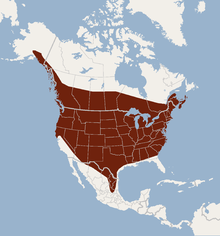Silver-haired bat
| Silver-haired bat | |
|---|---|
| | |
| Male silver-haired bat captured in the Ozark National Scenic Riverways in 2010. | |
| Scientific classification | |
| Kingdom: | Animalia |
| Phylum: | Chordata |
| Class: | Mammalia |
| Order: | Chiroptera |
| Family: | Vespertilionidae |
| Genus: | Lasionycteris Peters, 1866 |
| Species: | L. noctivagans |
| Binomial name | |
| Lasionycteris noctivagans (Le Conte, 1831) | |
 | |
| Distribution of the silver-haired bat (2009) | |
The silver-haired bat (Lasionycteris noctivagans) is a solitary migratory species of vesper bat in the family Vespertilionidae and the only member of the genus Lasionycteris.[2]
Etymology
The species name translates as night-wandering, referring to the nocturnal behavior of bats.
Description
This medium-sized bat is predominately black (including the wings, ears, interfemoral membrane, and fur) with white-tipped hairs. The basal upper half of its tail membrane is densely furred. This gives the bat a frosted appearance and its common name's sake. This species has a flattened skull with a broad rostrum.[3] This species weighs around 8–12 g, has a total length of ~100 mm, a tail length of 40 mm, and a forearm length of 37–44 mm.[4]
Distribution and habitat
Lasionycteris noctivagans is found in Bermuda, Canada, Mexico, and the United States. This forest inhabitant is known to occur from southeastern Alaska in summer to northeastern Mexico in winter [5] and is found in xeric habitats at low elevations during seasonal migrations. In Missouri, reproduction occurs in the northern dissected plains region, but reproductive females are believed to be absent from the southern Ozark highlands in the summer.
They often roost in tree cavities or in bark crevices on tree trunks, especially during migration. Their unique coloration makes them blend in with their roosting environment.[6]
Life history
Copulation of tree bats is likely initiated during flight. After mating, tree bats hibernate alone in tree cavities, bark crevices, beneath leaf litter, or in the twilight zone of caves. Gestation typically takes 50–60 days, so that parturition of pups occurs in early summer when insect availability is high.[7] Pups are born breech by presentation, and the mother consumes the placenta [8] Females typically give birth to two offspring, with an even sex ratio.
Diet and foraging behavior
Silver-haired bats consume primarily soft-bodies insects, such as moths, but will also take spiders and harvestmen. This species will forage low, over both still and running water, and also in forest openings. Silver-haired bats are slow but maneuverable flyers that typically detect prey a short distance away.[9]
Conservation threats
In addition to the hoary bat (Lasiurus cinereus) and eastern red bat (Lasiurus borealis), the silver-haired bat is one of the three tree bat species most commonly killed at wind energy facilities (over 75% of the mortalities).[10]
The causative agent of white-nose syndrome, Pseudogymnoascus destructans, has been detected on a silver-haired bat in Delaware, although this species does not suffer the same mass moralities observed in smaller-bodied hibernating North American cave bats.[11]
Like all bats, silver-haired bats are vulnerable to population threats because of their inherently low reproductive rate.[12]
Rabies
Most bats do not have rabies; however, most recent human rabies deaths have been due to a strain of rabies associated with this species.[6]
See also
References
- ↑ Arroyo-Cabrales, J.; Miller, B.; Reid, F.; Cuarón, A.D. & de Grammont, P.C. (2008). "Lasionycteris noctivagans". IUCN Red List of Threatened Species. Version 2009.2. International Union for Conservation of Nature. Retrieved 7 February 2010.
- ↑ Simmons, N.B. (2005). "Order Chiroptera". In Wilson, D.E.; Reeder, D.M. Mammal Species of the World: A Taxonomic and Geographic Reference (3rd ed.). Johns Hopkins University Press. p. 499. ISBN 978-0-8018-8221-0. OCLC 62265494.
- ↑ Kunz, T. 1982. Lasionycteris noctivagans. American Society of Mammalogists. No 172 pp. 1-5. http://www.jstor.org/stable/3504029
- ↑ "Silver-haired Bat". The Mammals of Texas – Online Edition.
- ↑ Cryan, P.M. 2003. Seasonal distribution of migratory tree bats (Lasiurus and Lasionycteris) in North America. Journal of Mammalogy 84(2): 579-593.
- 1 2 Coming in Contact with Bats. Centers for Disease Control and Prevention National Center for Emerging and Zoonotic Infectious Diseases (NCEZID) Division of High-Consequence Pathogens and Pathology (DHCPP).
- ↑ Hayssen, V., A. van Tienhoven, and A. van Tienhoven. 1993. Asdell’s patterns of mammalian reproduction. Comstock Publ. Assoc., Ithaca, NY.
- ↑ Kurta, A.D, and T.H. Kunz. 1987. Size of bats at birth and maternal investment during pregnancy. Symp. Zool. Soc. Lond. 57:79–106.
- ↑ Barclay, R.M.R. 1985. Long-versus short-range foraging strategies of hoary (Lasiurus cinereus) and silver-haired (Lasionycteris noctivagans) bats and the consequences for prey selection. Canadian Journal of Zoology. 63(11):2507–2515.
- ↑ Arnett, E. B. 2008. Patterns of fatality of bats at wind energy facilities in North America. Journal of Wildlife Management. 72:61–78.
- ↑ http://batcon.org/index.php/what-we-do/white-nose-syndrome/subcategory/466.html
- ↑ Barclay, R.M.R., J. Ulmer, C.J.A. MacKenzee, M.S. Thompson, L. Olson, J. McCool, E.E. Cropey, and G. Poll. 2004. Variation in the reproductive rate of bats. Canadian Journal of Zoology. 82, 688–693.
